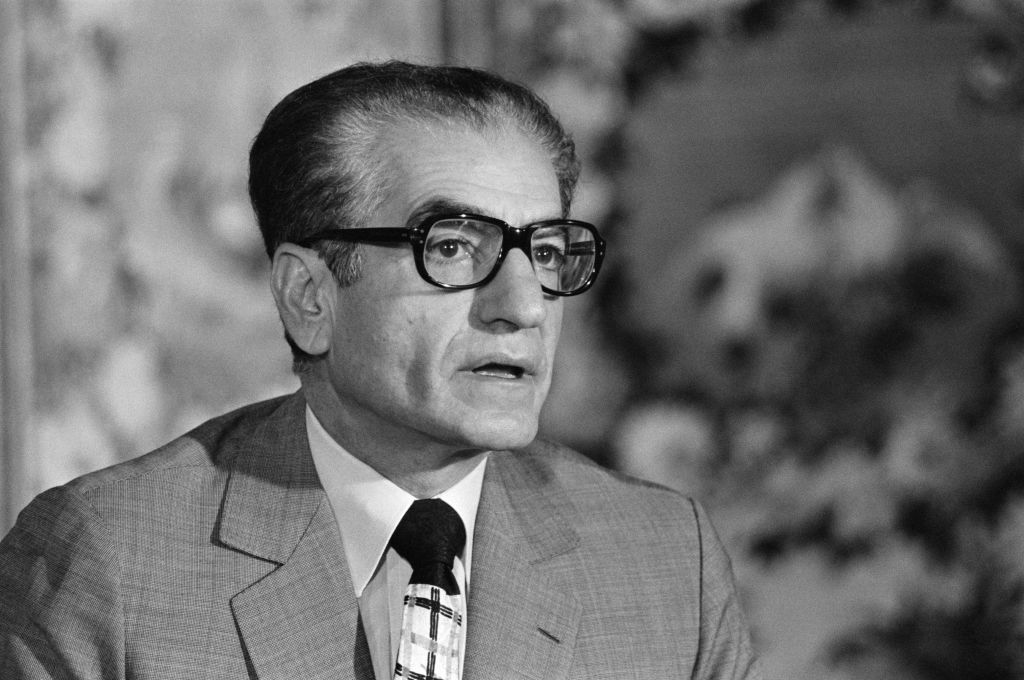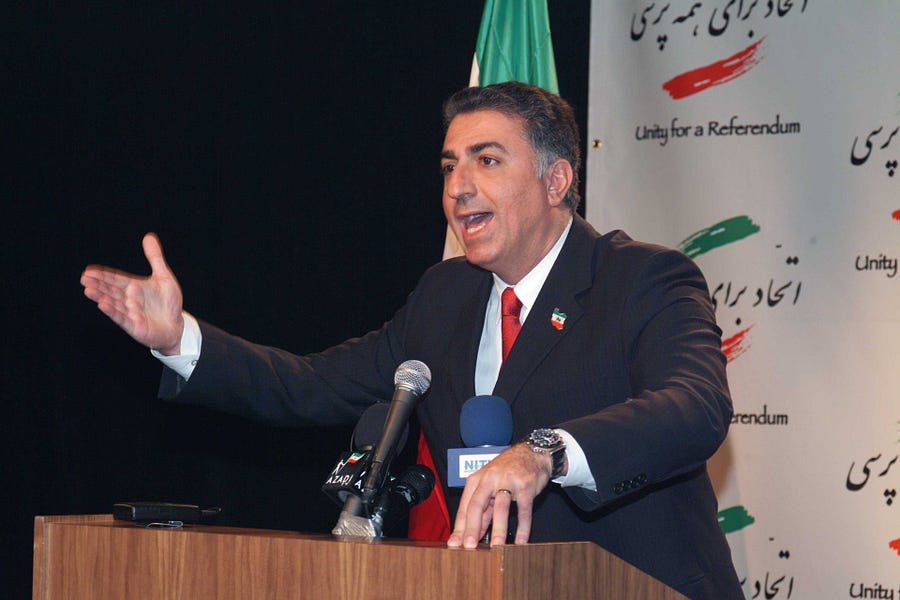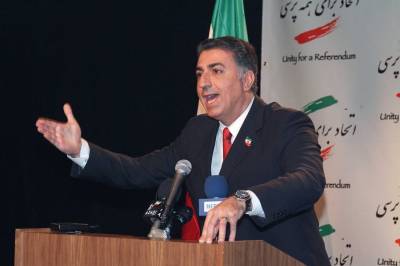More than a decade ago, something strange began to take root in Iran. In living rooms across the country—from Shiraz to Tehran to Mashhad—families gathered to tune into documentaries, singing competitions, cooking shows, and films all broadcast by a London-based Persian language channel. Manoto, launched in 2010, afforded viewers a rare glimpse into Iran’s pre-revolutionary past in the accessible form of entertainment programming. It has since amassed a viewership of 40 million strong.
One of the station’s most popular shows features archival footage and pictures of the country under Mohammad Reza Pahlavi, the late shah deposed in Iran’s 1979 uprising. The scenes of a bygone era reveal a strikingly modern society with reels of women dancing, young people drinking, actors starring in feature films, and the royal family jet-setting in the final years of its reign.
The deceptively simple model proved disruptive. In 2016, regime authorities seized and destroyed 100,000 satellite dishes and receivers, citing the power of foreign broadcasters to “deviate the society’s morality and culture.” In 2019, Iran’s ambassador to the United Kingdom accused Manoto of running “propagandistic” material using the Iranian people’s “plundered wealth.” And for years, Islamic Republic officials have created a public health crisis among Iran’s populace by jamming satellite signals using carcinogenic electromagnetic waves.
But despite Supreme Leader Ali Khamenei’s best efforts, Manoto and other diasporic networks exposed many Iranians to a period long obscured in the Islamic Republic’s official record. And to the clerical regime’s great alarm, reverberations of renewed interest in Iran’s monarchical history began to ring out in its streets.
In addition to explicit calls for regime change, many protesters of the past five years have invoked the Pahlavi name as a show of dissent: “Pahlavi! Pahlavi!” “Oh Shah of Iran, please return to Iran,” and “Reza Shah, may your spirit live on!” are among the slogans of recent demonstrations, which, unlike resistance movements of the past, have expanded to include new sectors of civil society—like oil workers and farmers—historically thought to make up the regime’s core base.
Khamenei himself appeared on state television in 2019 to condemn the unrest as the work of “evil actors,” including the Pahlavis, whom he accused of “inciting” the protests. While the family denies a direct hand in sowing dissent, the recent eruption of monarchist zeal has coincided with the re-emergence of Reza Pahlavi—the eldest son of the last shah and heir apparent to the throne—as a leading voice in the Iranian diaspora’s opposition. But his vision for Iran’s future government may surprise his critics and supporters alike.
After largely retreating from the limelight of his upbringing and early career in recent years, Pahlavi—perhaps conscious of his countrymen’s recent flirtation with pre-revolution—launched a loud and forceful crusade to rally the Trump administration’s support for Iranian protesters.
“Ultimately, the international community needs to accept two stark truths: Iran will not be able to establish a true democracy as long as this regime exists, and the people will not be able to overthrow it without foreign assistance,” Pahlavi said during a Washington Institute briefing in 2018, making an appeal for American moral and financial backing. “Leaders around the world have yet to express publicly that they support the protesters in their current struggle, and Iranians have noticed this silence.”
Around the same time, supporters of the exiled crown prince formed an opposition group known as Farashgard, a Zoroastrian term for the restoration or revival of moral goodness predating evil. In the organization’s founding statement, members advocated for the overthrow of the regime in Iran through civil disobedience and general strikes.
Pahlavi, now 61, also advocates for non-violent resistance as a tactic for regime change in Iran, looking to the movements of Dr. Martin Luther King Jr. and Nelson Mandela as inspiration. “How long can this last? It’s like if you were to ask this question a year before apartheid ended, or a year before the Soviet Union, as a regime, collapsed,” Pahlavi said during an interview with The Dispatch in the Washington, D.C., area where he now resides. “It’s a matter of time. It’s very hard to predict exactly when, but history is on the side of liberation.”
The regime’s response, meanwhile, has been “more guns, more repression, more executions,” Pahlavi said. Iran’s security forces killed an estimated 1,500 anti-regime demonstrators in a single two-week period in 2019, primarily in the capital city of Tehran. Ever since, the Islamic Republic’s crackdowns have followed a streamlined and highly lethal pattern: Disrupt internet access, make indiscriminate and mass arrests, and open fire on demonstrators as necessary.
As resentment toward the regime grows, the reactionary impulse of many within Iran has been to call for a return to the secular, Westernized reign of the Pahlavis. “It’s somewhat of a dichotomy,” Shay Khatiri—a participant in Iran’s 2009 Green Revolution and founding member of Farashgard—told The Dispatch. “When the regime becomes less popular, the Pahlavis become more popular.”
The head of the University of Pennsylvania’s Middle East Center, John Ghazvinian, described the resurgence of royal nostalgia as an “expression of frustration” for some Iranians. “There’s a rebellious element, I think,” he said. “If you’re unhappy with your government, you look for the things that are most likely to annoy them.”
Islamic Republic-led propaganda campaigns taught in primary schools and circulated in state media depict the fallen dynasty as demonic, imperialist, and morally depraved. One particular claim popularized by the regime following 1979 alleged that the last shah was in a homosexual relationship, an offense punishable by torture and execution under the current theocratic regime.

The deposed dynasty’s taboo in Iran is rivaled perhaps only by its anathema in Washington, where the Pahlavi name conjures images of CIA-backed regime change—though experts have recently pushed back on that interpretation of the shah’s ascent to power. Perhaps more controversial among American academics and policymakers were the late shah’s moves to crush political dissent, particularly toward the end of his rule. In 1975, Mohammad Reza Pahlavi outlawed the country’s political parties in favor of a one-party system.
“The shah had some accomplishments that he could point to, many supporters, but one thing that he didn’t do was involve any genuine avenues for political participation among the people. By the 1970s, the shah had become a pretty brutal dictator and presided over one of the largest and most ruthless secret police forces in the world,” Ghazvinian told The Dispatch, referring to the monarchy’s infamous SAVAK secret police.
But it didn’t take long following the return of Ruollah Khomenei, the Islamic Republic’s founder, for a sense of buyer’s remorse to set in for some one-time revolutionaries. “The crown was, in my opinion, replaced by a turban,” said Nader Nouri, a former Iranian diplomat under the shah and participant in 1979’s uprising. “Nothing really changed.”
In March 1979, just five weeks after Khomeini’s arrival from Paris, Iranian women staged mass demonstrations in opposition to compulsory veiling. Eight months later, the capture of the U.S. embassy in Tehran and ensuing hostage crisis isolated revolutionaries who warned against Iran’s transformation into a pariah state. By 1981, the Mujahedin-e-Khalq (MEK) had launched its costly campaign against the regime and the Islamic Republic’s first president, Abolhassan Banisadr, had been forced out of office for his suspected sympathies with the group.
“A lot of the people who did rise up in 1979 had no idea what they wanted in return for getting rid of the shah. By the time they realized what they got, i.e., Khomeinism, they came to regret it deeply,” Alex Vatanka, head of the Middle East Institute’s Iran program, told The Dispatch.
“Their revolution’s been shrinking for 42 years,” Vatanka added. “If they didn’t have political freedoms under the shah, at least they had social freedoms. After he left, they didn’t gain political freedoms and they lost their social freedoms.”
Leading voices in the Iranian diaspora now hope to capitalize on the current supreme leader’s weakened support. Many Iranians at home seem to be with them.
While it remains difficult to gauge public opinion under an autocratic system, a 2021 poll by the Group for Analyzing and Measuring Attitudes in Iran (GAMAAN) used multiple chain-referral sampling (in which respondents recruit more respondents) to analyze the views of literate Iranian residents 19 and older, about 85 percent of the country’s total population. Of the poll’s respondents, 86 percent said that “domestic inefficiency and corruption” inflicted a worse toll on Iran’s economy than outside pressures, with only 10 percent attributing their hardships primarily to “foreign sanctions and pressures.”
The country’s dwindling resources, Pahlavi said, are “not spent on the people,” but on the Islamic Revolutionary Guard Corps and its goal of exporting the revolution to neighboring states. “People know that as they are starving, people know that as they are struggling.” Iranian protesters have long chanted different variations of a popular slogan—”Not Gaza, Not Lebanon, My Life For Iran”—in opposition to the regime’s sponsorship of militias across the Middle East.
Only 16 percent of GAMAAN respondents wanted to “preserve the principles and values of the revolution,” while 35 percent backed the wholesale overthrow of the Islamic Republic.
Iranian voters’ boycott of the 2021 presidential election, which saw the supreme leader-orchestrated victory of Ebrahim Raisi, also sent a “clear message to the outside world,” Pahlavi argued. Last June’s vote had both the lowest turnout in the clerical government’s history at just shy of 49 percent and the highest percentage of blank and invalid ballots at 14 percent.
Asked their preferred form of government, 31 percent of respondents to the GAMAAN poll opted for a secular republic and 16 percent chose a secular constitutional monarchy. Those two groups seem to overlap when asked about their chosen candidate in a “completely free election,” with more than 29 percent of respondents—a plurality almost double that of the second-place name—throwing their support behind the son of the last shah.
“In the past two years, so many people are shouting and asking him to be a leader, talking about his grandfather, and talking about his father,” said Arash, a Tehran-based dissident. “They need a leader, because Iranian people without a leader go nowhere.”
But Pahlavi, who bears a striking resemblance to his father, denies ambitions to head Iran either as a monarch or as an elected official. “I don’t see my role to be that, nor am I inclined to do that, nor am I interested to do that,” he told The Dispatch. “I think authority sometimes changes people’s nature and behavior.”

Three months after his father’s death from lymphatic cancer in 1980, and on his 20th birthday, Pahlavi swore in as successor to his family’s throne in Cairo’s Koubbeh Palace. But exile has changed his perspective. Last year, a leaked audio clip of Pahlavi voicing private support for a republican form of government sent shockwaves through the Iranian diaspora. “As a democrat I can’t justify heredity as a basis for the selection of a person of authority, even in the symbolic sense,” he can be heard saying. “Iranians do not need a ‘master.’”
Pahlavi now views his role as providing guidance should the Iranian people transition from dictatorship to some form of secular, representative government. “It would be premature for us to reach a conclusion today,” he said. “On the other hand, we should encourage all sorts of healthy debates so people this time—as opposed to 42 years ago, when they had no clue what it is they were going to end up with—have a clear understanding and idea of the options available.”
But some criticize Pahlavi’s unwillingness to commit to a next step, particularly given infighting among opponents of the regime.
“Iranians are generally divided on whether they want a republican or monarchic government, and he has failed to either take a side on this issue or end the debate,” said Khatiri, who since his founding of Farashgard has grown disillusioned with opposition politics. “By avoiding it or failing to resolve it, he’s just prolonging it and prolonging the division.”
For four decades, the Islamic Republic’s opposition has largely coalesced around a common enemy rather than a shared set of goals or values. Members of the MEK—one of the regime’s largest diasporic rivals—dismiss the son of the shah as a political opportunist with a dark family history. Pahlavists, meanwhile, accuse the MEK of having a cult-like hierarchy, Marxist and Islamist leanings, and next-to-no support inside Iran given its backing of Saddam Hussein during the Iran-Iraq War.
“You cannot claim that you have a democratic agenda when, from the point of view of organizational structure and behavior, it’s the exact opposite of tolerance and freedom of speaking,” Pahlavi said, asked by The Dispatch about opposition groups—including the MEK—with fundamentally different visions for Iran’s future. But, he added: While opposition groups often clash on the government’s “final form,” they generally agree that the only way to address these divisions is in a Free Iran.
The massive size and reach of the Iranian diaspora, at more than 4 million people worldwide, further undermines efforts to unify.
“Historically, there are relatively few instances of multiple opposition actors getting along to the point where they form a single political voice,” Norman Roule, former U.S. national intelligence manager for Iran, told The Dispatch. “Iran’s opposition is challenged further by rivalries and a wide diversity of political views.”
The son of the shah’s continued reluctance to confront the darker moments in his family’s history has also provoked criticism from political rivals, particularly those who partook in the revolution but have since fallen out with the clerical regime. Asked in 1989 about his father’s legions of secret police—best known for their indiscriminate imprisonment and torture of political prisoners—Pahlavi pointed to instances of police violence elsewhere to minimize the throne’s role.
“Yes, there were cases of police brutality. And I don’t condone it,” Pahlavi said at the time. “But if the New York City police department is using electric shock guns to mistreat violators, then that’s police brutality. Can you hold a president accountable?”
Nouri, the former Iranian diplomat and participant in the 1979 revolution, said that the Iranian people have been “held hostage” by dictatorial leaders for more than a century. “I don’t believe that you can hold a son responsible for the deeds of his father,” he added. “The problem is that he has never clearly condemned some of the crimes his father committed.”
Pahlavi avoids mentioning the events that precipitated 1979, focusing instead on Iran’s future. The Iranian government in its current form, he told The Dispatch, is “simply not tenable” amid the Iranian people’s increasingly frequent displays of discontent. And with the mid-February deadline for the international community to revive the Obama-era Iran nuclear deal fast approaching, Tehran may miss its window to secure sanctions relief.
According to a recent story by Politico, indirect negotiations between Washington and Tehran to curb Iran’s uranium enrichment program have entered their “final stage” but risk deteriorating amid unresolved disagreements. But many, Pahlavi included, argue that diplomacy with the end goal of shaping the Islamic Republic’s behavior for the better was always doomed to fail.
“At the end of the day [the Islamic Republic] is buying time, because they think they can outlast a given administration in the West,” Pahlavi said. “We’ve seen ebbs and flows, but the regime’s tactic has always been consistent in one way and that is playing the world for fools.”







Please note that we at The Dispatch hold ourselves, our work, and our commenters to a higher standard than other places on the internet. We welcome comments that foster genuine debate or discussion—including comments critical of us or our work—but responses that include ad hominem attacks on fellow Dispatch members or are intended to stoke fear and anger may be moderated.
With your membership, you only have the ability to comment on The Morning Dispatch articles. Consider upgrading to join the conversation everywhere.